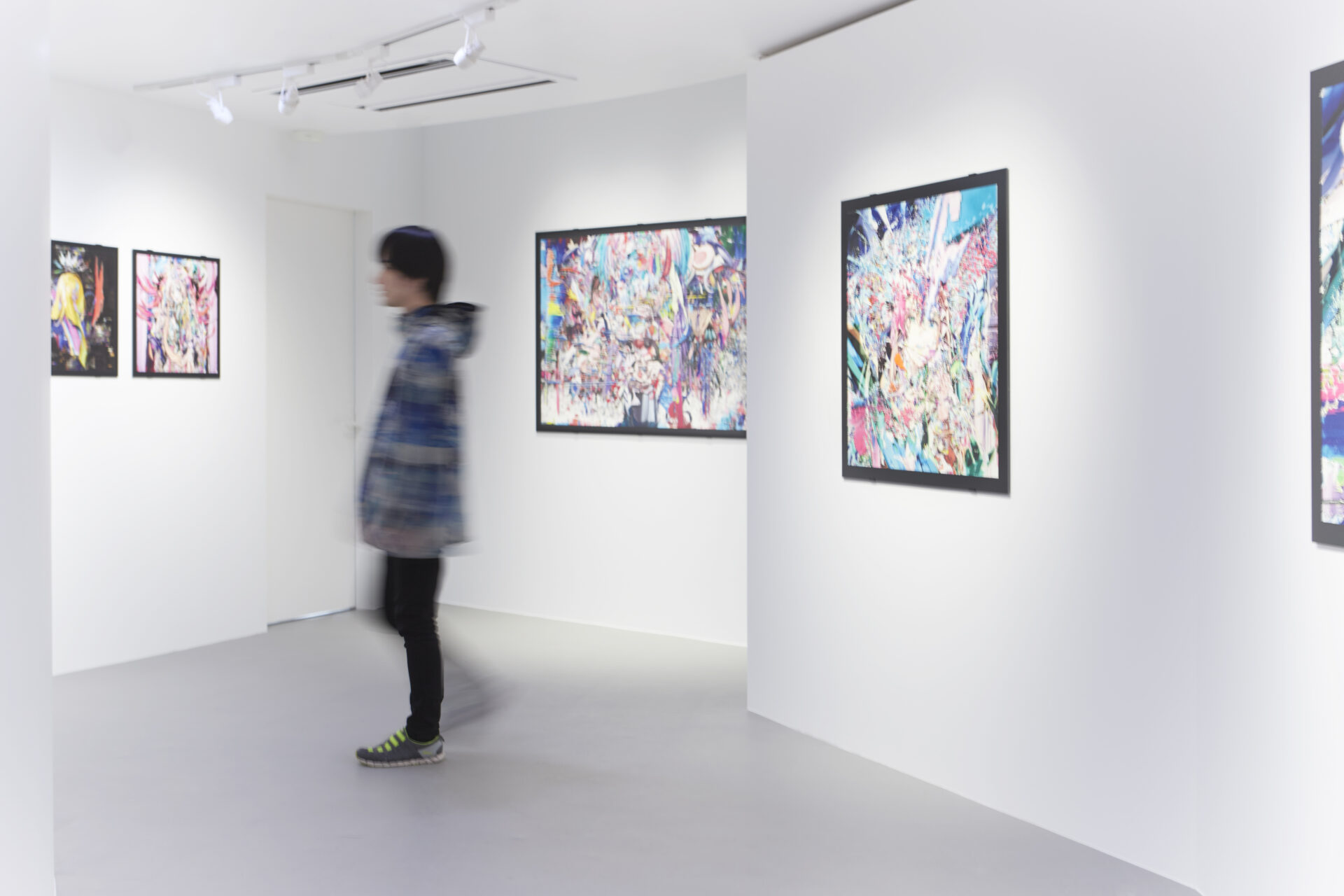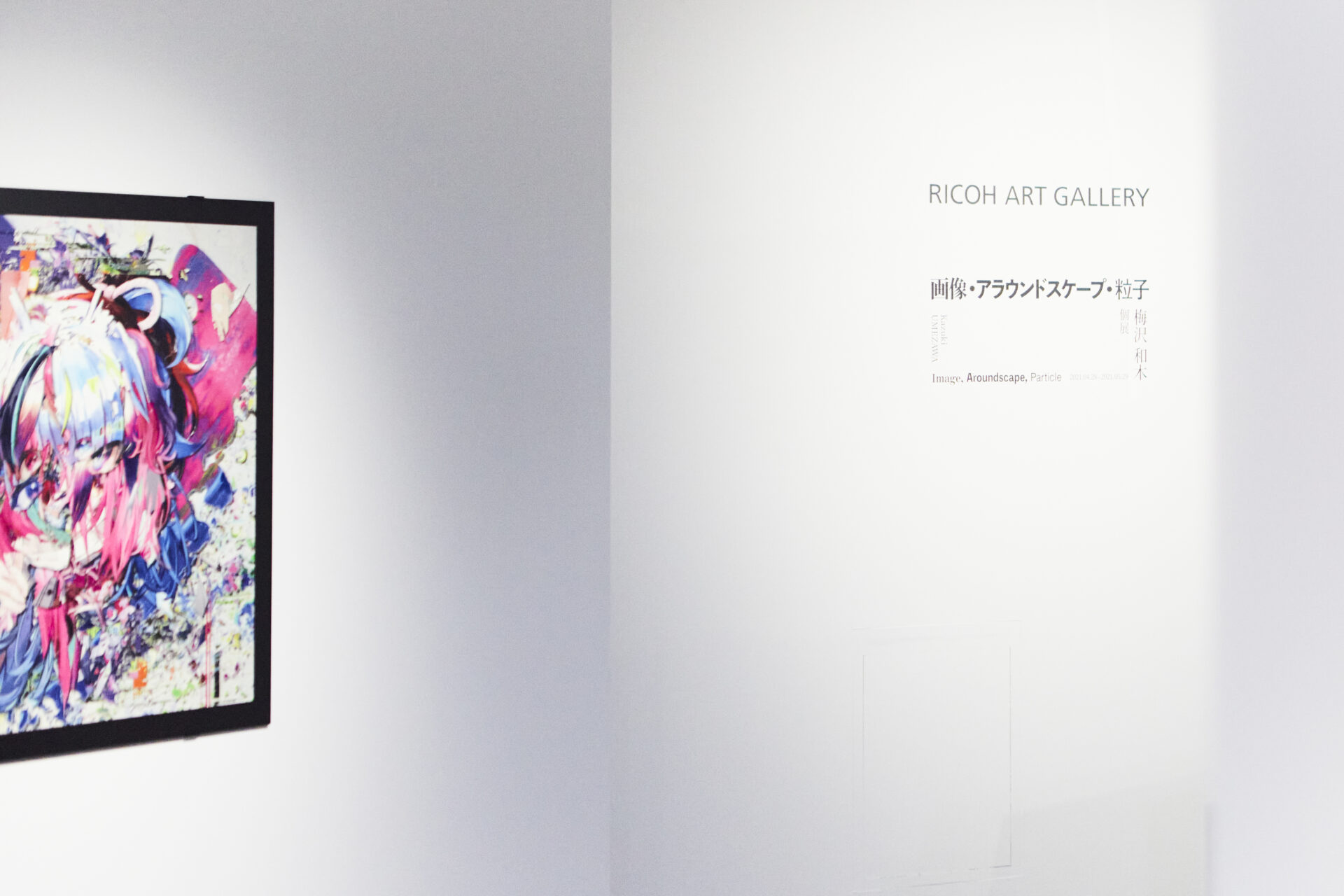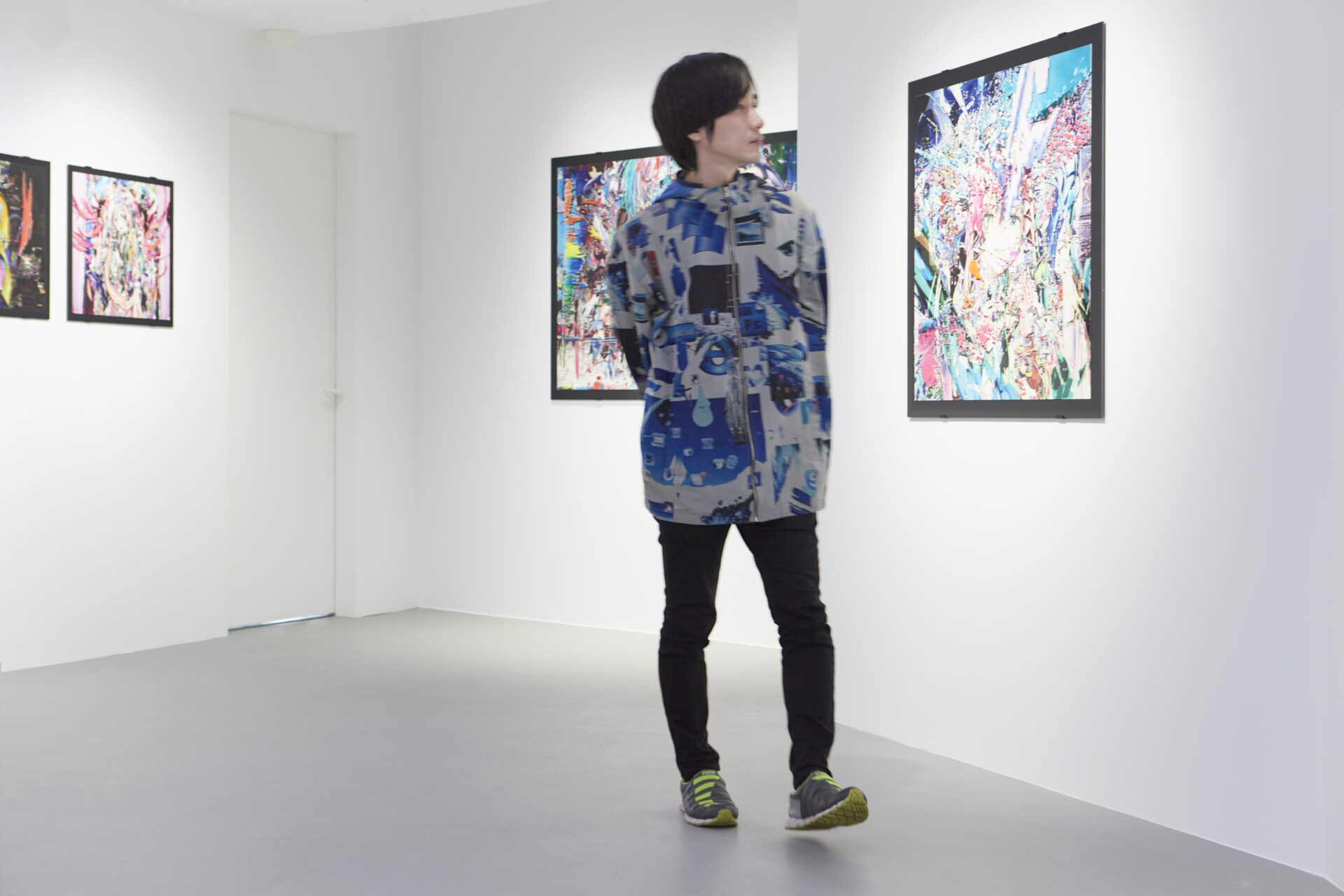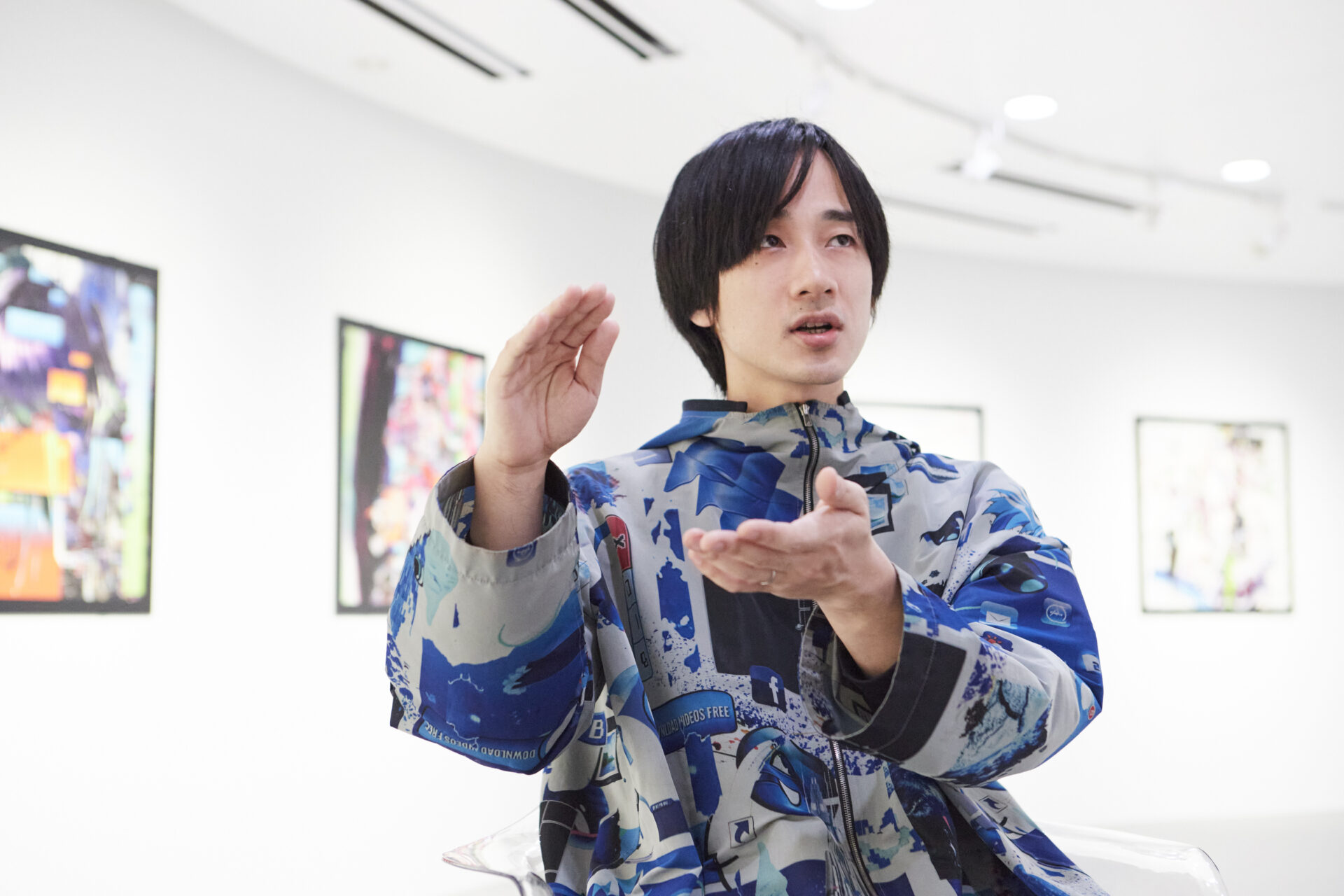REPORT

Contemporary artist Kazuki Umezawa is a perfect specimen of a child of the 10s. When we asked him what he thought of this description he, in a slightly shy way, answered “I have a deep attachment to the subculture of that time, and I would like to renew that culture.”
The material that his work is based on is images of games and animation characters that he finds on the internet, or his own photographs and scanned traces of his paintings. He creates a digital collage and, upon printing, layers glitter pens and acrylic paint to complete his unique visual world. Umezawa began to exhibit work created through this process around 2008, a time in which the terms ‘10s’ was already widely used. It was also in the era of Twitter, and Niconico had gained recognition online.
“I was so into the animation that was uploaded on the internet then. The colors of the characters and the expression of form were like nothing I had seen before. The comments and tags on Niconico’s video screen and the flowing timeline of Twitter were both amazing. My parents were artists and taught painting, and I had enjoyed painting since my childhood. So I thought, ‘Could I develop the reality of the content that I loved into painting?’ ‘Could the overwhelming volume of information content on the internet and the flow of information be visualized like a landscape?’ These ideas are the starting point of the work, and I can say that I am still pursuing them.”
For more than a decade since then he has created work and received great acclaim both domestically and internationally. His basic production method does not seem to have changed much, but the process of using images has renewed the gaze and mind of the artist, both in ways he was aware and unaware of. “The internet and real society are connected. For example, after the Tohoku earthquake, for some time there were almost no images on the internet except those of the earthquake. In such times I think: “what can I express now?” – in other words, the emotions and themes behind the work change. Ongoing events in society and personal interests often meet, when explored deeply, with the issues in my own expression.”
This exhibition foregrounds a co-creation with a new technology. The 15 new pieces on display are all produced with StareReap―a 2.5 dimensional printing technology. The title, ‘Image, Aroundscape, Particle|, is a list of words that symbolize the work of Umezawa; it is the image as material, with landscapes around the images formed from them (‘aroundscape’ is an original word), and particles in the pixels of digital images and the atoms that construe the world. “In printing, these are converted to particles and pressed onto paper. And StareReap has an incredible level of accuracy. It is all even and homogenized, which is why we can express differences of just a couple of millimeters.”
This characteristic is described by Umezawa with the example of a coffee grinding mill. “I once researched the difference between a standard mill that cost about 3000 yen with a high end one worth tens of thousands. Top quality mills can grind the beans to a regular size. Finer is not necessarily better: evenly coarse grind can give a course-ground taste, while evenly fine grind can give a fine-ground taste. The same particles throughout express the taste and flavor intended when the hot water is poured. This may be similar to the relationship between ink and paper―not just with StareReap, but with printing technology in general.”
The actual work is expressed with motifs reconstructed in layers – in other words, a three-dimensional expression of two-dimensional images. Some have ink in a semi-spherical form, like a dome, while others have solid, three-dimensional parts, resembling a collection of pixels. Umezawa says that there are even some details that he added following meetings with the StareReap engineers and technicians―like shadows. “The different surface levels create real shadows on the work, but there are also shadows that I have graphically painted, like a kind of trick-art. When we tried it we all thought it looked really good, so I added it in some parts.”
There are some places where only the bumps on the surface make patterns, and even some where you cannot tell if it was painted by the artist or expressed by the machine. The expression, shaking the borders between digital and analogue, reality and fiction, shows the essence of Umezawa. And this never-before-seen landscape of images in three dimensions gives a new effect that holds the eyes of the audience on the work.
The material that his work is based on is images of games and animation characters that he finds on the internet, or his own photographs and scanned traces of his paintings. He creates a digital collage and, upon printing, layers glitter pens and acrylic paint to complete his unique visual world. Umezawa began to exhibit work created through this process around 2008, a time in which the terms ‘10s’ was already widely used. It was also in the era of Twitter, and Niconico had gained recognition online.
“I was so into the animation that was uploaded on the internet then. The colors of the characters and the expression of form were like nothing I had seen before. The comments and tags on Niconico’s video screen and the flowing timeline of Twitter were both amazing. My parents were artists and taught painting, and I had enjoyed painting since my childhood. So I thought, ‘Could I develop the reality of the content that I loved into painting?’ ‘Could the overwhelming volume of information content on the internet and the flow of information be visualized like a landscape?’ These ideas are the starting point of the work, and I can say that I am still pursuing them.”
For more than a decade since then he has created work and received great acclaim both domestically and internationally. His basic production method does not seem to have changed much, but the process of using images has renewed the gaze and mind of the artist, both in ways he was aware and unaware of. “The internet and real society are connected. For example, after the Tohoku earthquake, for some time there were almost no images on the internet except those of the earthquake. In such times I think: “what can I express now?” – in other words, the emotions and themes behind the work change. Ongoing events in society and personal interests often meet, when explored deeply, with the issues in my own expression.”
This exhibition foregrounds a co-creation with a new technology. The 15 new pieces on display are all produced with StareReap―a 2.5 dimensional printing technology. The title, ‘Image, Aroundscape, Particle|, is a list of words that symbolize the work of Umezawa; it is the image as material, with landscapes around the images formed from them (‘aroundscape’ is an original word), and particles in the pixels of digital images and the atoms that construe the world. “In printing, these are converted to particles and pressed onto paper. And StareReap has an incredible level of accuracy. It is all even and homogenized, which is why we can express differences of just a couple of millimeters.”
This characteristic is described by Umezawa with the example of a coffee grinding mill. “I once researched the difference between a standard mill that cost about 3000 yen with a high end one worth tens of thousands. Top quality mills can grind the beans to a regular size. Finer is not necessarily better: evenly coarse grind can give a course-ground taste, while evenly fine grind can give a fine-ground taste. The same particles throughout express the taste and flavor intended when the hot water is poured. This may be similar to the relationship between ink and paper―not just with StareReap, but with printing technology in general.”
The actual work is expressed with motifs reconstructed in layers – in other words, a three-dimensional expression of two-dimensional images. Some have ink in a semi-spherical form, like a dome, while others have solid, three-dimensional parts, resembling a collection of pixels. Umezawa says that there are even some details that he added following meetings with the StareReap engineers and technicians―like shadows. “The different surface levels create real shadows on the work, but there are also shadows that I have graphically painted, like a kind of trick-art. When we tried it we all thought it looked really good, so I added it in some parts.”
There are some places where only the bumps on the surface make patterns, and even some where you cannot tell if it was painted by the artist or expressed by the machine. The expression, shaking the borders between digital and analogue, reality and fiction, shows the essence of Umezawa. And this never-before-seen landscape of images in three dimensions gives a new effect that holds the eyes of the audience on the work.
Contemporary artist Kazuki Umezawa is a perfect specimen of a child of the 10s. When we asked him what he thought of this description he, in a slightly shy way, answered “I have a deep attachment to the subculture of that time, and I would like to renew that culture.”
The material that his work is based on is images of games and animation characters that he finds on the internet, or his own photographs and scanned traces of his paintings. He creates a digital collage and, upon printing, layers glitter pens and acrylic paint to complete his unique visual world. Umezawa began to exhibit work created through this process around 2008, a time in which the terms ‘10s’ was already widely used. It was also in the era of Twitter, and Niconico had gained recognition online.
“I was so into the animation that was uploaded on the internet then. The colors of the characters and the expression of form were like nothing I had seen before. The comments and tags on Niconico’s video screen and the flowing timeline of Twitter were both amazing. My parents were artists and taught painting, and I had enjoyed painting since my childhood. So I thought, ‘Could I develop the reality of the content that I loved into painting?’ ‘Could the overwhelming volume of information content on the internet and the flow of information be visualized like a landscape?’ These ideas are the starting point of the work, and I can say that I am still pursuing them.”
For more than a decade since then he has created work and received great acclaim both domestically and internationally. His basic production method does not seem to have changed much, but the process of using images has renewed the gaze and mind of the artist, both in ways he was aware and unaware of. “The internet and real society are connected. For example, after the Tohoku earthquake, for some time there were almost no images on the internet except those of the earthquake. In such times I think: “what can I express now?” – in other words, the emotions and themes behind the work change. Ongoing events in society and personal interests often meet, when explored deeply, with the issues in my own expression.”
This exhibition foregrounds a co-creation with a new technology. The 15 new pieces on display are all produced with StareReap―a 2.5 dimensional printing technology. The title, ‘Image, Aroundscape, Particle|, is a list of words that symbolize the work of Umezawa; it is the image as material, with landscapes around the images formed from them (‘aroundscape’ is an original word), and particles in the pixels of digital images and the atoms that construe the world. “In printing, these are converted to particles and pressed onto paper. And StareReap has an incredible level of accuracy. It is all even and homogenized, which is why we can express differences of just a couple of millimeters.”
This characteristic is described by Umezawa with the example of a coffee grinding mill. “I once researched the difference between a standard mill that cost about 3000 yen with a high end one worth tens of thousands. Top quality mills can grind the beans to a regular size. Finer is not necessarily better: evenly coarse grind can give a course-ground taste, while evenly fine grind can give a fine-ground taste. The same particles throughout express the taste and flavor intended when the hot water is poured. This may be similar to the relationship between ink and paper―not just with StareReap, but with printing technology in general.”
The actual work is expressed with motifs reconstructed in layers – in other words, a three-dimensional expression of two-dimensional images. Some have ink in a semi-spherical form, like a dome, while others have solid, three-dimensional parts, resembling a collection of pixels. Umezawa says that there are even some details that he added following meetings with the StareReap engineers and technicians―like shadows. “The different surface levels create real shadows on the work, but there are also shadows that I have graphically painted, like a kind of trick-art. When we tried it we all thought it looked really good, so I added it in some parts.”
There are some places where only the bumps on the surface make patterns, and even some where you cannot tell if it was painted by the artist or expressed by the machine. The expression, shaking the borders between digital and analogue, reality and fiction, shows the essence of Umezawa. And this never-before-seen landscape of images in three dimensions gives a new effect that holds the eyes of the audience on the work.
The material that his work is based on is images of games and animation characters that he finds on the internet, or his own photographs and scanned traces of his paintings. He creates a digital collage and, upon printing, layers glitter pens and acrylic paint to complete his unique visual world. Umezawa began to exhibit work created through this process around 2008, a time in which the terms ‘10s’ was already widely used. It was also in the era of Twitter, and Niconico had gained recognition online.
“I was so into the animation that was uploaded on the internet then. The colors of the characters and the expression of form were like nothing I had seen before. The comments and tags on Niconico’s video screen and the flowing timeline of Twitter were both amazing. My parents were artists and taught painting, and I had enjoyed painting since my childhood. So I thought, ‘Could I develop the reality of the content that I loved into painting?’ ‘Could the overwhelming volume of information content on the internet and the flow of information be visualized like a landscape?’ These ideas are the starting point of the work, and I can say that I am still pursuing them.”
For more than a decade since then he has created work and received great acclaim both domestically and internationally. His basic production method does not seem to have changed much, but the process of using images has renewed the gaze and mind of the artist, both in ways he was aware and unaware of. “The internet and real society are connected. For example, after the Tohoku earthquake, for some time there were almost no images on the internet except those of the earthquake. In such times I think: “what can I express now?” – in other words, the emotions and themes behind the work change. Ongoing events in society and personal interests often meet, when explored deeply, with the issues in my own expression.”
This exhibition foregrounds a co-creation with a new technology. The 15 new pieces on display are all produced with StareReap―a 2.5 dimensional printing technology. The title, ‘Image, Aroundscape, Particle|, is a list of words that symbolize the work of Umezawa; it is the image as material, with landscapes around the images formed from them (‘aroundscape’ is an original word), and particles in the pixels of digital images and the atoms that construe the world. “In printing, these are converted to particles and pressed onto paper. And StareReap has an incredible level of accuracy. It is all even and homogenized, which is why we can express differences of just a couple of millimeters.”
This characteristic is described by Umezawa with the example of a coffee grinding mill. “I once researched the difference between a standard mill that cost about 3000 yen with a high end one worth tens of thousands. Top quality mills can grind the beans to a regular size. Finer is not necessarily better: evenly coarse grind can give a course-ground taste, while evenly fine grind can give a fine-ground taste. The same particles throughout express the taste and flavor intended when the hot water is poured. This may be similar to the relationship between ink and paper―not just with StareReap, but with printing technology in general.”
The actual work is expressed with motifs reconstructed in layers – in other words, a three-dimensional expression of two-dimensional images. Some have ink in a semi-spherical form, like a dome, while others have solid, three-dimensional parts, resembling a collection of pixels. Umezawa says that there are even some details that he added following meetings with the StareReap engineers and technicians―like shadows. “The different surface levels create real shadows on the work, but there are also shadows that I have graphically painted, like a kind of trick-art. When we tried it we all thought it looked really good, so I added it in some parts.”
There are some places where only the bumps on the surface make patterns, and even some where you cannot tell if it was painted by the artist or expressed by the machine. The expression, shaking the borders between digital and analogue, reality and fiction, shows the essence of Umezawa. And this never-before-seen landscape of images in three dimensions gives a new effect that holds the eyes of the audience on the work.

Kazuki Umezawa
Born in 1985 in Saitama. A contemporary artist. Graduated from Musashino Art University Department of Imaging Arts and Sciences. Past exhibitions include ‘LOVE’ (Mori Museum, 2013), ‘Tokyo Pop Underground’ (Jeffrey Deitch, New York/Los Angeles, 2013) and ‘Weavers of Worlds: A Century of Flux in Japanese Modern/Contemporary Art’ (MOT, 2019). There are many collectors of his work, and some pieces are held by the MOT and Mori Museum.
www.umelabo.info
Exhibition details
‘Image, Aroundscape, Particle’
Dates: June 5th – July 3rd 2021
Venue: RICOH ART GALLERY
Sanai Dream Center 8th, Ginza 5-7-2, Chuo, Tokyo
Closed on Mondays, Sundays and holidays
Born in 1985 in Saitama. A contemporary artist. Graduated from Musashino Art University Department of Imaging Arts and Sciences. Past exhibitions include ‘LOVE’ (Mori Museum, 2013), ‘Tokyo Pop Underground’ (Jeffrey Deitch, New York/Los Angeles, 2013) and ‘Weavers of Worlds: A Century of Flux in Japanese Modern/Contemporary Art’ (MOT, 2019). There are many collectors of his work, and some pieces are held by the MOT and Mori Museum.
www.umelabo.info
Exhibition details
‘Image, Aroundscape, Particle’
Dates: June 5th – July 3rd 2021
Venue: RICOH ART GALLERY
Sanai Dream Center 8th, Ginza 5-7-2, Chuo, Tokyo
Closed on Mondays, Sundays and holidays
Kazuki Umezawa
Born in 1985 in Saitama. A contemporary artist. Graduated from Musashino Art University Department of Imaging Arts and Sciences. Past exhibitions include ‘LOVE’ (Mori Museum, 2013), ‘Tokyo Pop Underground’ (Jeffrey Deitch, New York/Los Angeles, 2013) and ‘Weavers of Worlds: A Century of Flux in Japanese Modern/Contemporary Art’ (MOT, 2019). There are many collectors of his work, and some pieces are held by the MOT and Mori Museum.
www.umelabo.info
Exhibition details
‘Image, Aroundscape, Particle’
Dates: June 5th – July 3rd 2021
Venue: RICOH ART GALLERY
Sanai Dream Center 8th, Ginza 5-7-2, Chuo, Tokyo
Closed on Mondays, Sundays and holidays
Born in 1985 in Saitama. A contemporary artist. Graduated from Musashino Art University Department of Imaging Arts and Sciences. Past exhibitions include ‘LOVE’ (Mori Museum, 2013), ‘Tokyo Pop Underground’ (Jeffrey Deitch, New York/Los Angeles, 2013) and ‘Weavers of Worlds: A Century of Flux in Japanese Modern/Contemporary Art’ (MOT, 2019). There are many collectors of his work, and some pieces are held by the MOT and Mori Museum.
www.umelabo.info
Exhibition details
‘Image, Aroundscape, Particle’
Dates: June 5th – July 3rd 2021
Venue: RICOH ART GALLERY
Sanai Dream Center 8th, Ginza 5-7-2, Chuo, Tokyo
Closed on Mondays, Sundays and holidays
In the Japanese title, three words are connected by a point: ・ . This point is also used in the title of the well known book by art critic Noi Sawaragi, ‘Japan・Contemporary・Art’. “This ‘point’ is often used in the names of skills in games,” Umezawa laughs, “You could say it is quite Japanese in expression”.

In the Japanese title, three words are connected by a point: ・ . This point is also used in the title of the well known book by art critic Noi Sawaragi, ‘Japan・Contemporary・Art’. “This ‘point’ is often used in the names of skills in games,” Umezawa laughs, “You could say it is quite Japanese in expression”.
Umezawa directs the uneven dips and peaks, and the StareReap technicians adjust the number of layers to complete the work. Umezawa explains, “the hundreds of layers that I made are classified into nine levels, and I have given direction for each work. And there are further differences expressed by StareReap.”

Umezawa directs the uneven dips and peaks, and the StareReap technicians adjust the number of layers to complete the work. Umezawa explains, “the hundreds of layers that I made are classified into nine levels, and I have given direction for each work. And there are further differences expressed by StareReap.”

Umezawa walks through the exhibition site. The exhibited pieces can be purchased only by visitors, by lottery. See here for details.
Umezawa walks through the exhibition site. The exhibited pieces can be purchased only by visitors, by lottery. See here for details.

“The exquisite sense of three-dimensionality created by StareReap and the texture that is fine but also sharp on the surface is difficult to realize by the human hand. There is a great possibility for something new to be created when technologies like StareReap are combined with the creativity that humans are so adept at.”
“The exquisite sense of three-dimensionality created by StareReap and the texture that is fine but also sharp on the surface is difficult to realize by the human hand. There is a great possibility for something new to be created when technologies like StareReap are combined with the creativity that humans are so adept at.”
